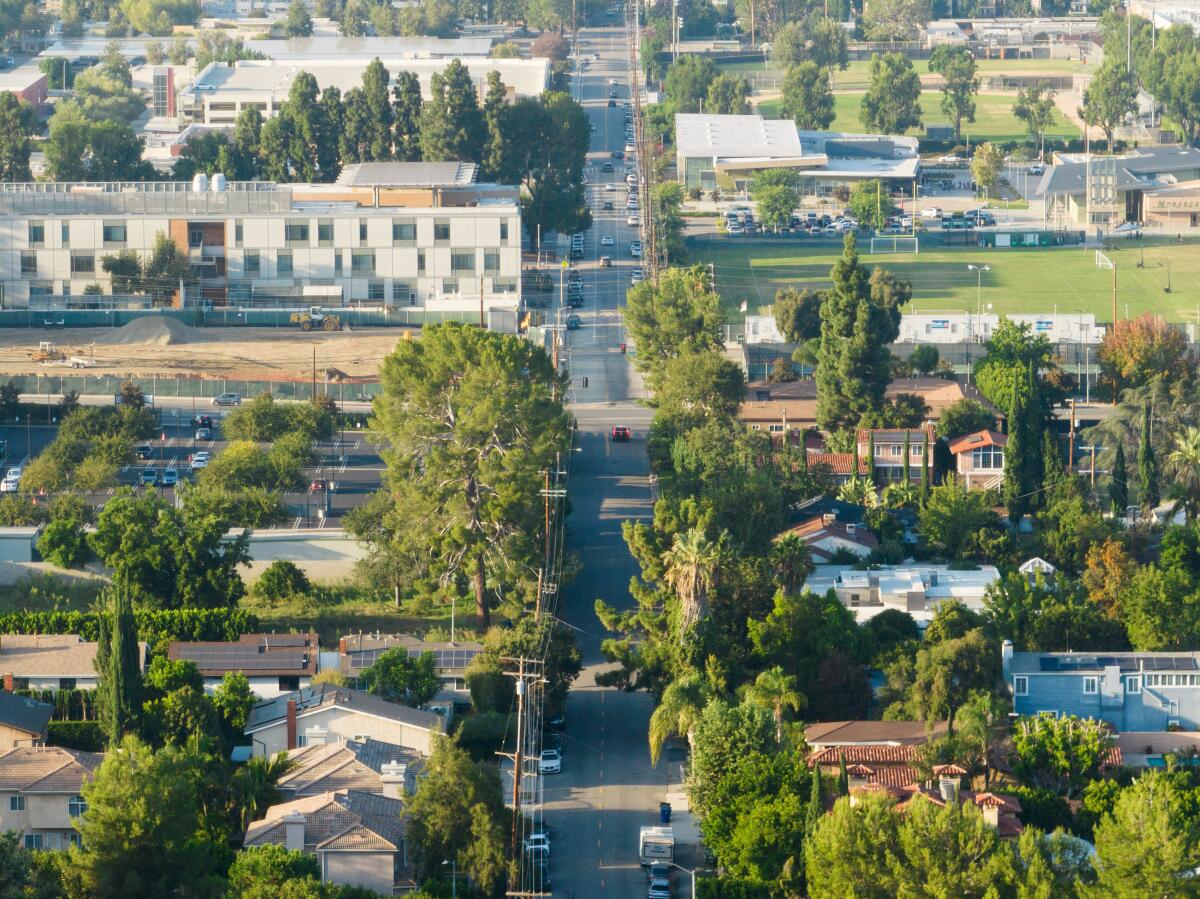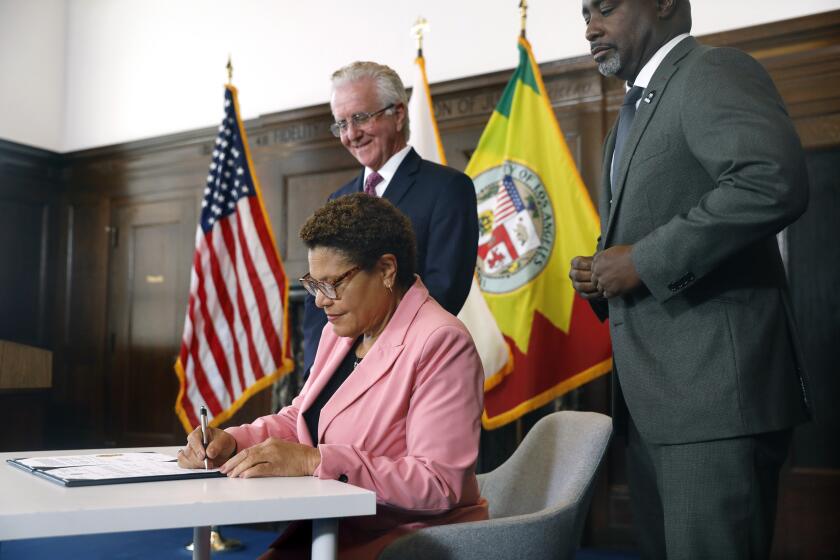Why is L.A. still letting single-family homeowners block solutions to the housing crisis?

- Share via
Last month YIMBY Law, a nonprofit, pro-housing advocacy group, sued the City of Los Angeles on behalf of a private developer seeking to construct a 360-unit apartment building in Canoga Park. These apartments would be only for renters who meet the federal definition of low to moderate incomes in L.A. The project was submitted under Mayor Karen Bass’ Executive Directive 1, meant to dramatically speed up the approval and permitting process for 100% affordable housing projects. But recently the city revoked the eligibility of the Canoga Park building for this program following complaints from single-family homeowners.
This about-face is part of a trend. Last year, the mayor’s office amended ED1 to shield single-family zones from streamlined development — after eight such applications, including the Canoga Park proposal, were already submitted. Those proposals were then denied eligibility for ED1. Some of the projects have filed appeals; one denial has been overturned, but the City Council rejected an appeal for the Canoga project.
Without ED1, these projects face a discretionary approval process that may involve lengthy environmental review and other delays likely to prevent them from happening. This turn of events may cost the city more than 1,100 affordable apartments.
Executive Directive 1 turned on the tap for construction of new, and desperately needed affordable housing. The City Council should make it permanent.
Bass announced ED1 as moving “City Hall away from its traditional approach that is focused on process and replacing it with a new approach focused on solutions, results and speed.” The mayor’s stated intention received a remarkable boost via the state law AB 2334, passed in 2022, allowing developer incentives for 100% affordable projects including substantial increases in height limits and allowable density (the number of housing units on a given-sized parcel of land) in “very low vehicle travel areas,” where limited residential development has kept down traffic. The idea is that these areas can more easily accommodate any extra traffic stemming from increased housing density.
The potential cost savings from ED1 and AB 2334 encouraged private developers to produce long-term, income-restricted units — crucially, without relying on public financing. If the more than 1,100 apartments now held up from ED1 streamlining were built through the standard publicly subsidized pathway, at a typical cost of around $600,000 per unit, they could require up to $660,000,000 in public funding. Privately funded alternatives are a boon to local, regional and state governments that have sought for years to spur the production of so-called “missing middle” housing that is affordable to working-class and middle-income households.
The city might make permanent a directive from Mayor Bass that streamlines development. But in its current form, the policy threatens to make low-income Angelenos homeless.
Yet now this progress is in question, just as the power of these complementary city and state reforms has begun to emerge. The lawsuit concerning the Canoga Park building may result in one or more of the halted projects being built eventually, and the state has suggested that the city erred in revoking their ED1 eligibility. But even if these projects get approved, since ED1 now excludes the single-family neighborhoods that make up approximately three-quarters of residential land in L.A., they would mark an end rather than a beginning to similar development.
Some residents of these neighborhoods say that’s only fair. According to Councilmember Bob Blumenfield, for homeowners affected by new apartments, “their property value is going to get cut in half, they’re going to have a big shadow over their place.”
As it happens, I can speak personally to these concerns. I am the owner and resident of a unit in a small rowhouse condo development on the Westside located directly across the street from an ongoing project converting a single-family home into a multi-unit apartment building.
My neighbors and my family are losing a good deal of sunlight throughout the day from the new building. Our street has been a cacophonous, messy construction site for so long it’s hard to remember what it was like before.
In trying to prevent homelessness, the city and county have passed numerous measures that make it impossible for small landlords to function and will shut more renters out of the market.
But I know that this is what solving the housing crisis looks like: A single parcel that previously housed one family is being transformed into apartments for perhaps 15 to 25 people, with units reserved for low-income households. Like those in the contested ED1 projects, these affordable units won’t require public funding.
There is simply no way to solve our housing crisis without throwing shade in some single-family residential areas. We might have to increase traffic in some neighborhoods, too, though providing more housing in jobs-rich West L.A. could ultimately reduce traffic by allowing people to live closer to where they work. As for property values, multiple studies have shown that low-income housing does not substantially reduce them, including in high-cost neighborhoods, and often increases them.
Some constituencies will always oppose development. Local policymakers who are serious about solving our dual crises of housing affordability and homelessness have to take a hard look at how much political capital they are willing to spend to create effective policies in the face of such objections.
If we can’t build fully affordable projects that don’t drain government coffers even on the edges of land zoned for single-family residences, then Angelenos should prepare for a permanent housing crisis.
But if this sounds like the wrong direction for the city, Bass and the City Council should fully commit to protecting and expanding innovative policy such as the original ED1, without categorical exclusions for single-family neighborhoods, and AB 2334. Mechanisms that convince private developers to produce long-term affordable housing offer what is as close to a free lunch on this crisis as L.A. is ever likely to get.
Jason Ward is an economist at Rand Corp. and the co-director of the Rand Center on Housing and Homelessness.
More to Read
A cure for the common opinion
Get thought-provoking perspectives with our weekly newsletter.
You may occasionally receive promotional content from the Los Angeles Times.












